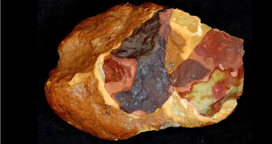In this recent week of class, we covered the Kessler Syndrome. The concept arose in our course reading — Dr Space Junk Vs The Universe by Alice Gorman — and briefly appeared in our lecture notes. The Kessler Syndrome describes an extreme theoretical scenario where space debris collisions reach the point of self-replication, which jeopardizes or cuts off space activities (Whitt 2022). Learning about this theory prompted an investigation into the current issue of space debris and mitigation efforts.
The present pace of the Space industry’s expansion is unsustainable and dangerous. There have grown to be 170 million pieces of space debris in orbit (Khlystov 2023). These “pieces” consist of small and large sections of dead satellites, flecks of paint, bolts, spent rocket bodies, and more (Khlystov 2023). The vast majority of space debris is small and untrackable due to technological limits in the U.S. Space Surveillance Network (Khlystov 2023). Space debris in LEO (Low Earth Orbit) travels roughly 17,000 mph, making any collision with space technology extremely detrimental (Khlystov 2023). These collisions produce more fragments, which exponentially worsens debris congestion. The Kessler Syndrome is a growing possibility.
Space debris mitigation is categorized into short-term and long-term strategies. Short-term techniques address immediate risks, while long-term techniques reduce the total amount of mass and kinetic energy in orbit (Press 2023). Long-term strategies are therefore the most effective for preventing Kessler Syndrome. Some long-term strategies include deorbiting or lifetime reduction, using disposal orbits, and active in-orbit debris removals (Press 2023).
Deorbiting involves retrograde propulsion, while lifetime reduction involves drag augmentation devices (Press 2023). Retrograde propulsion entails small rocket thrusters that direct spacecraft out of debris (Figure 1) (Press 2023). The spacecraft may be guided to a predetermined location on Earth or an orbit of a shorter lifetime (Press 2023). The latter is followed by an uncontrolled reentry and burn-up (Press 2023). Drag augmentation involves using devices, like inflatable balloons, to increase the surface area and thus drag of a spacecraft (Press 2023). Increasing drag accelerates orbital decay, which reduces orbital altitude (The Physics Teacher). The object may then reenter the Earth’s atmosphere and burn up.
Figure 1. A depiction of the mechanism behind rocket maneuvering thrusters. Photograph by F. Barbir.
Disposal orbits are regions that do not contain direct collisional hazards for spacecraft (Press 2023). Spacecraft often reorbit into disposal orbits at the end of their functional lifetime (Press 2023). Reorbitting uses two propulsive burns — similar to retrograde propulsion — to steer the spacecraft into a disposal orbit (Press 2023).
Various schemes of active in-orbit removal technology have been devised. However, these propositions are too costly for practical implementation (Press 2023). One proposal was a “debris sweeper” with foam balls or braking foils that sift through debris to deorbit them (Press 2023). Another proposal was “space-based laser evaporation” (Figure 2) of debris material (Press 2023). Further discussion among space experts could produce more cost-efficient and feasible strategies.
Figure 2. A schematic depiction of a space-based laser in function. Photograph by Alexander Rubenchik, Michail Fedoruk, and Sergei Turistyn.
While long-term mitigation techniques have been developed, their impact on the high concentration of space debris seems limited. Deorbiting, lifetime reduction, and using disposal orbits protect spacecraft by relocating them away from hazardous debris conditions and preventing additional debris generation. However, only in-orbit removal technology directly decreases the amount of existing debris. This technology is not currently viable. Consequently, space debris and the Kessler Syndrome are enduring threats.
Additional Content:
Garcia, Marisa. December 2, 2023. “Airbus Detumbler for Satellite End of Life Addresses
Space Junk Crisis.” Forbes. https://www.forbes.com/sites/marisagarcia/2023/12/01/airbus-detumbler-for-satellite-end-of-life-addresses-space-junk-crisis/?sh=7016e4153462.
Young, Chris. November 24, 2023. “11 Organizations Tackling the Space Debris Problem.”
Interesting Engineering. https://interestingengineering.com/lists/11-organizations-space-debris-problem.
Reference List:
Barbir, F. December 3, 2023 “Spacecraft Propulsion.” ScienceDirect Topics.
https://www.sciencedirect.com/topics/earth-and-planetary-sciences/spacecraft-propulsion.
Fiolhais, Miguel. Gonzalez-Urbina, Luis. Milewski, Tomasz. Chapparo, Carlos. Ferroglia,
Andrea. December 3, 2023. “Orbital Decay in the Classroom.” Pubs.Aip.Org. https://pubs.aip.org/aapt/pte/article/61/3/182/2869907/Orbital-Decay-in-the-Classroom.
Khlystov, Nikolai. December 3, 2023. “We Have a Space Debris Problem. Here’s How to
Solve It.” World Economic Forum. https://www.weforum.org/agenda/2018/04/we-have-a-space-debris-problem-heres-how-to-solve-it/.
Press, National Academy. December 3, 2023. “7 Techniques to Reduce the Future Debris
Hazard.” The National Academies Press. https://nap.nationalacademies.org/read/4765/chapter/10.
Rubenchik, Alexander. Fedoruk, Michail. Turistyn, Sergei. April 11, 2014 “The Effect of
Self-Focusing on Laser Space-Debris Cleaning.” Nature News. https://www.nature.com/articles/lsa201440.
Whitt, Kelly. September 20, 2022. “Kessler Syndrome of Colliding Satellites Could Make
Low-Earth Orbit Unusable.” EarthSky. https://earthsky.org/human-world/kessler-syndrome-colliding-satellites/.

